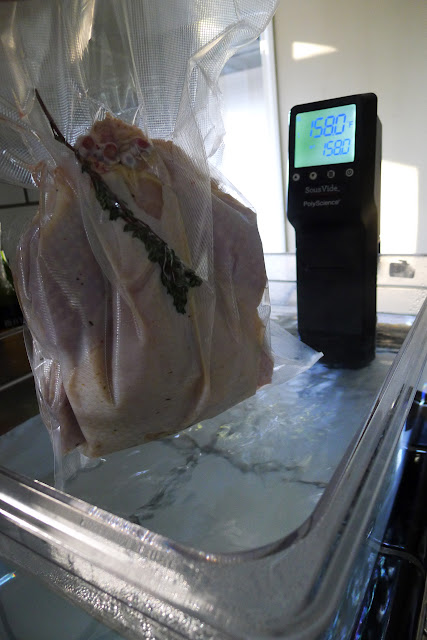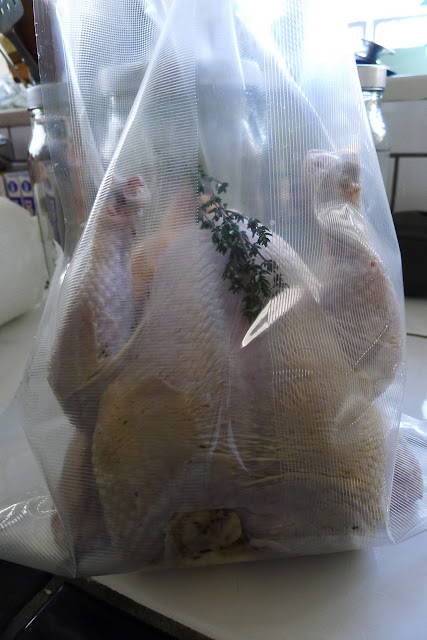Not many people can say they've sous vide'd a whole chicken. As of last Monday, I can.
Tony Maws, the mastermind behind Craigie on Main in Cambridge, MA, shares this roast chicken recipe on his website. And the recipe is daunting. Believe you me, the thought of brining, vacuum sealing, and dunking an entire chicken into a hot water bath seemed very near threatening at first, but after going through the process once, it ain't so bad after all. If you're lucky enough to own an immersion circulator, or have a friend who has one, like I do, taking the day to prepare and watch over this preparation of roast chicken is well worth the effort and wait.
First, combine the ingredients for the brine and bring the brine to a simmer. Water, kosher salt, kombu (11 grams, to be exact), dried thyme, coriander seeds, fennel seeds, allspice berries, juniper berries, chili flakes, and cloves. Forget bath salts. The resulting aroma of this brine is eye-rollingly soothing.
After letting the brine cool, dunk the chicken into the liquid. I used a resealable bag and flipped the bag once after one-and-a-half hours of brining to make sure the brine would find its way into every crevice of the chicken.
After about two hours of brining, start warming a tub of water to 158 degrees Fahrenheit with an immersion circulator. Don't underestimate how long this might take. After all, 158 degrees is a pretty high temperature. After three hours of brining, the chicken should look a little something like this. Don't worry if you can't get all the aromatics off of the chicken.
Next, wipe the chicken dry, season the chicken with salt and pepper, and place the chicken, chicken or duck fat, and a sprig of thyme into a vacuum seal bag.
And vacuum seal away. I was a little worried here that there might still be brine remnants that would get sucked into the vacuum, but everything was gravy.
At this point, the water tub should have reached 158 degrees. Dunk the chicken into the hot water bath.
After 2.5 hours in the hot water bath, take the bag out and let the chicken rest for 20 minutes.
As the chicken is resting, fill a tub with cold water and ice. Once the chicken is done resting, place the bag into the cold water for at least 1.5 hours to allow the chicken to chill. When the chicken gets cold enough to your liking, preheat the oven to 425 degrees.
Take the chicken out of the bag and wipe off as much of the "gelled juice" as possible. Be really careful when you're doing this step because the skin can tear very easily. And don't worry if the chicken takes on the color of that preserved fetal pig you might have dissected in high school. The final oven roasting step will take care of any concerns you might have about the form or color of the chicken.
When the oven's ready, pop the chicken in for 40 minutes. The chicken should take on a welcomingly familiar brown color.
Finally, rest the chicken for 10 minutes. The final product should smell like a classic roast chicken and have a slightly crispy skin.
The first cut was divine. Because I was so taken aback by how perfectly cooked the inner thigh was, I immediately took the carving knife to the breast. Just as I had hoped, the breast was cooked to perfection from skin to rib. The dark meat bursted with flavor and depth. Juices purged their way out of the lower thigh and inner breast, and the innermost meat took on an ever so slight pink tinge that indicated that the meat was cooked to just the right temperature.
Ah, the magic of sous vide cooking. I mean seriously, look at that exposed chicken breast. Some of the breast meat was so juicy that it almost felt like sashimi when I placed it on my tongue. The simple salt and pepper seasoning let the poultry shine and the somewhat loose, yet still crispy skin added some texture to each bite.
Even though none of the thyme and not much of the brine's flavors came through, several bites had fleeting hints of coriander and allspice. Usually three hungry people can rip through a chicken like nobody's business. But the meat on this chicken was so juicy, rich, and succulent that my mom, brother, and I had trouble stuffing ourselves with anything beyond a normal portion of chicken. I guess that's why people say that a well-cooked chicken feeds more than a mediocre chicken.
Okay, fine. You're right. People don't say that. But they should.
Not to spoil the results, but I'll tell you right now that this chicken is easily going to snag a spot in the top five.


why do all the photos show the temperature of the immersion circulator at 158 whereas recipe cooks at 185?
ReplyDeleteGah! Good catch. It's supposed to be 158. My bad. Changing it now.
ReplyDeleteI often use Foodsaver gamesaver deluxe to seal roast chicken, the machine that cheap and very helpful. I don't have to worry about the way to keep roast chicken fresh any more.
ReplyDeletethis is a bs recipe. the time/temps suggested don't result in a properly cooked chicken. my sous vide cooker is accurate; my oven is accurate. the bird wasn't close to done. i assume chef maw is yanking us around. geez guys--check stuff.
ReplyDeleteI'm not sure about sous vide a whole chicken but still nice to khow someone did it.
ReplyDelete